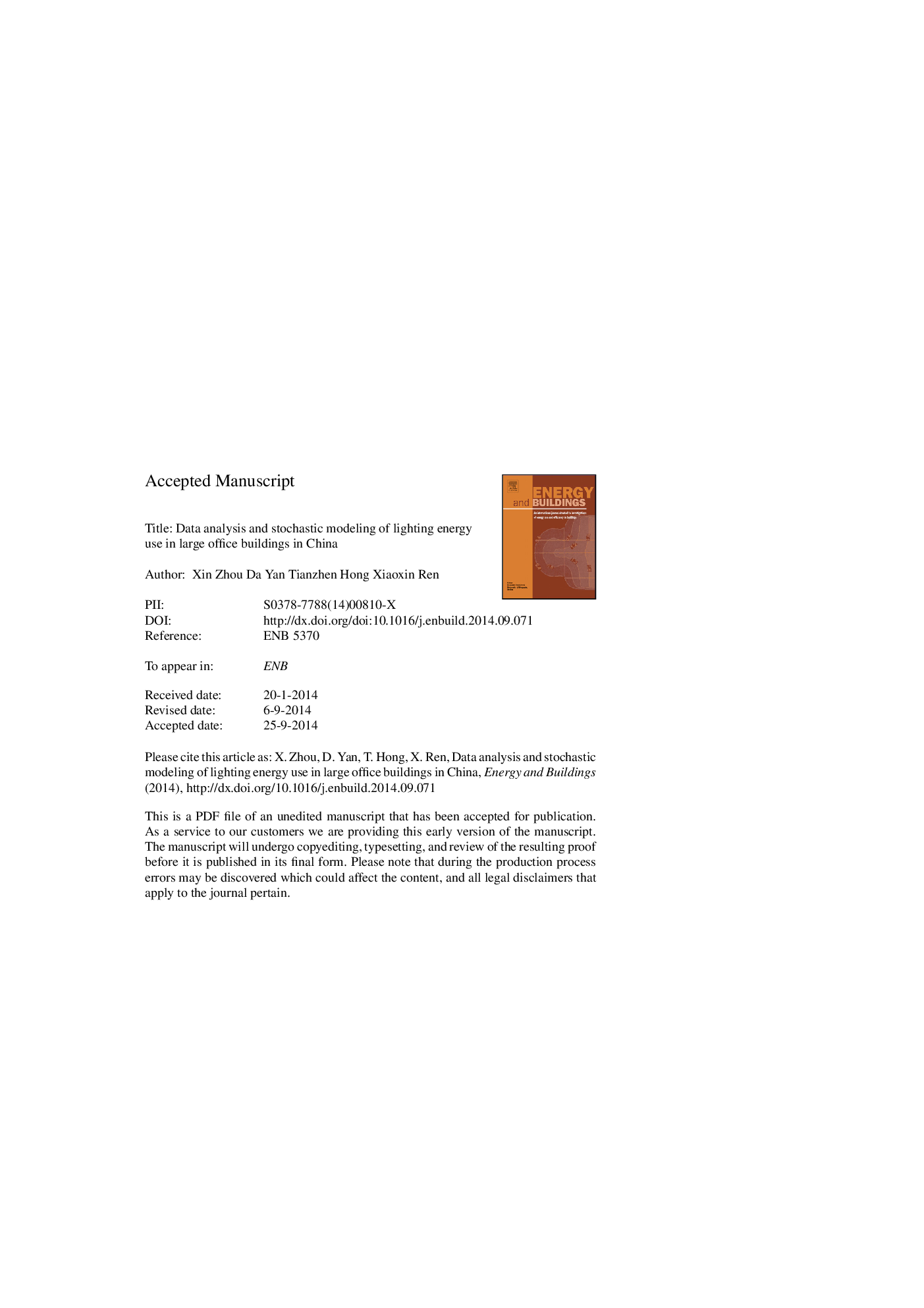| کد مقاله | کد نشریه | سال انتشار | مقاله انگلیسی | نسخه تمام متن |
|---|---|---|---|---|
| 6732730 | 504045 | 2015 | 62 صفحه PDF | دانلود رایگان |
عنوان انگلیسی مقاله ISI
Data analysis and stochastic modeling of lighting energy use in large office buildings in China
ترجمه فارسی عنوان
تجزیه و تحلیل داده ها و مدل سازی تصادفی از استفاده از انرژی نور در ساختمان های اداری بزرگ در چین
دانلود مقاله + سفارش ترجمه
دانلود مقاله ISI انگلیسی
رایگان برای ایرانیان
کلمات کلیدی
شبیه سازی ساختمان، استفاده از انرژی، مدل سازی نورپردازی، رفتار شغلی، ساختمان های اداری، توزیع پواسون، مدل سازی تصادفی،
ترجمه چکیده
روشنایی مصرف 20 تا 40 درصد کل مصرف برق در ساختمان های اداری بزرگ در چین را مصرف می کند. به طور معمول در ایجاد شبیه سازی، برنامه زمان بندی استاتیک برای روزهای هفته، تعطیلات آخر هفته و تعطیلات به صورت پویایی استفاده از انرژی نور در ساختمان ها مطرح می شود. این رویکرد به طبیعت تصادفی استفاده از انرژی روشنایی توجه نمی کند که می تواند تحت تاثیر رفتار ساکنان در ساختمان ها قرار گیرد. این مطالعه ویژگی های اصلی استفاده از انرژی نور را براساس تجزیه و تحلیل آماری داده های استفاده از انرژی نور سنج اندازه گیری شده از 15 ساختمان بزرگ اداری در پکن و هنگ کنگ مورد بررسی قرار می دهد. مشخص شد که در این ساختمان های اداری بزرگ، تغییرات 24 ساعته در مصرف انرژی نور به طور عمده توسط برنامه های ساکنان ساختمان انجام می شود. سطوح روشنایی در فضای باز به دلیل عدم کنترل خودکار نور روز (اندازه گیری اثربخشی مکمل برای کاهش مصرف نور انرژی) و محیط پیرامون محیطی نسبتا کوچک در معرض نور طبیعی، تاثیر کمی بر مصرف نور انرژی داشت. یک مدل استفاده از انرژی روشنایی تصادفی برای ساختمان های بزرگ اداری برای توسعه فعالیت های مختلف مسافر در شش دوره زمانی مختلف در طول روز و همچنین توزیع سالانه برق روشنایی در این دوره ها توسعه یافت. مدل با استفاده از اندازه گیری انرژی نور سنجی از 15 ساختمان تأیید شد. مدل روشنایی تصادفی توسعه می تواند برنامه های دقیق تر نور را برای استفاده در شبیه سازی انرژی ساختمان، بهبود دقت شبیه سازی مصرف انرژی نور در ساختمان های واقعی تولید کند.
موضوعات مرتبط
مهندسی و علوم پایه
مهندسی انرژی
انرژی های تجدید پذیر، توسعه پایدار و محیط زیست
چکیده انگلیسی
Lighting consumes about 20% to 40% of the total electricity use in large office buildings in China. Commonly in building simulations, static time schedules for typical weekdays, weekends and holidays are assumed to represent the dynamics of lighting energy use in buildings. This approach does not address the stochastic nature of lighting energy use, which can be influenced by occupant behavior in buildings. This study analyzes the main characteristics of lighting energy use over various timescales, based on the statistical analysis of measured lighting energy use data from 15 large office buildings in Beijing and Hong Kong. It was found that in these large office buildings, the 24-hourly variation in lighting energy use was mainly driven by the schedules of the building occupants. Outdoor illuminance levels had little impact on lighting energy use due to the lack of automatic daylighting controls (an effective retrofit measure to reduce lighting energy use) and the relatively small perimeter area exposed to natural daylight. A stochastic lighting energy use model for large office buildings was further developed to represent diverse occupant activities, at six different time periods throughout a day, and also the annual distribution of lighting power across these periods. The model was verified using measured lighting energy use from the 15 buildings. The developed stochastic lighting model can generate more accurate lighting schedules for use in building energy simulations, improving the simulation accuracy of lighting energy use in real buildings.
ناشر
Database: Elsevier - ScienceDirect (ساینس دایرکت)
Journal: Energy and Buildings - Volume 86, January 2015, Pages 275-287
Journal: Energy and Buildings - Volume 86, January 2015, Pages 275-287
نویسندگان
Xin Zhou, Da Yan, Tianzhen Hong, Xiaoxin Ren,
